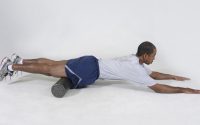ITB: Extrapolating results from research to hands-on manual therapy should be done with caution—Joe Muscolino
I always enjoy research and the conclusions that are reached from the studies, but extrapolating to hands-on manual therapy should be done with caution. As I read the Falvey et al.’s study, it purports to show that:
- The ITB has little or no ability to stretch, and
- there is no bursa located between the lateral femoral condyle and the ITB.
Therefore, it is unlikely that an ITB friction syndrome exists; and that trying to stretch the ITB, specifically by foam rolling, is not only not a valuable clinical manual/movement therapy technique, but a deleterious one.
My specialty is more macro-kinesiology than micro-kinesiology as discussed here. But here are my general thoughts and concerns regarding the study’s findings and conclusions:
- The tissue used had an age of 76 +/- 10 years. This means that all subjects were elderly, the tissue was not representative of younger or even middle-aged individuals. Soft tissues in elderly people tend to be less plastic and elastic.
- Perhaps the presence or lack thereof of a bursa may be influenced by the age of the cadaver subjects.
- Beyond all this, I never like to make conclusions based on research alone. I love research, but it should not allow us to ignore well-known principles of anatomy/physiology/kinesiology/histology. To wit, all soft tissue is to some degree elastic and plastic. Fascia is more so plastic than elastic, meaning it can be deformed, meaning it can adapt to forces placed upon it. Indeed, the principle of “creep” states that soft tissue is deformable when a sustained force is placed upon it. To state that the ITB cannot be stretched at all is to throw this well-accepted principle away. Certainly, much of the purpose of dense fibrous fascial tissue such as tendons and ligaments (and the ITB is effectively a tendon for the TFL and gluteus maximus) is to have great tensile strength, meaning that it does resist stretch. Otherwise, tendons would stretch every time that a muscle contracted, meaning that the muscle’s contraction force would never be exerted on its attachments. But, having said this, even dense fascial tissue must be somewhat plastic and therefore deformable/stretchable.
- Given that all soft tissue is somewhat amendable to manual therapy, foam rolling, or massage for that matter, should be somewhat effective. However, given the dense nature of the ITB, I would believe that the manual therapy would have to be performed in a very disciplined manner over a long period of time (months or years) to be effective.
- In some ways, the conclusion of this study reminds me of the controversy over stretching in general. There are still many people out there who claim in some manner that stretching does not work. Yet, every study I have read shows that IF stretching is done in a disciplined manner over a long period of time, it is effective at increasing flexibility. If the act of placing a tensile (stretching) force can have absolutely no effect upon mechanically deforming fascial soft tissue, then it would seem that we are doomed to becoming ever increasingly tighter and rigid as we age. In a larger picture, this makes no sense to me. I cannot see how movement, whether it is formal stretching or non-formal stretching that occurs as a result of the normal movement of an active lifestyle can have no effect on fascial tissue. Fascial tissue is a mechanical structure that should be able to respond to mechanical forces. To ignore this is to ignore the entire realm of biomechanics.
- I am actually the last person who should be countering this article’s principle tenet because I believe that ITB syndrome does not occur anywhere near as often as it is purported to exist. When ITB friction syndrome does exist, it should be located directly at the lateral femoral condyle (or perhaps at the greater trochanter), but not anywhere along the middle of the ITB, as it is so often claimed to be present. In my opinion, the vast majority of pain anywhere along the ITB (other than the lateral femoral condyle or the greater trochanter) that is blamed on the ITB is actually due to tightness in the underlying vastus lateralis or vastus intermedius. And if this is true, then I would find that foam rolling (or massage) would compress the vastus musculature, which would be a good thing. After all, massage/manual therapy does work the vast majority of the time by compressing soft tissue. So to claim that foam rolling is deleterious is to effectively negate the entire field of manual therapy. (One can think of the wonderful Gil Hedley “Fuzz Speech” in which he describes the benefit of movement and manual therapy toward decreasing the build-up of fascial tissue.) I realize that the author of the study might not intend to make this claim, but it seems the inescapable conclusion of claiming that pressure from foam rolling should be avoided (unless he is simply ignoring the possible role of the underlying vastus lateralis and vastus intermedius tissue).
All in all, I find that using the results of this study as a basis for the conclusions that
1) ITB friction syndrome does not exist, and
2) manual compression therapy (read: foam rolling) is absolutely ineffective, or worse, deleterious,
would be an unsubstantiated reach.
Joseph E. Muscolino, DC, is a chiropractor in private practice in Stamford, CT who employs extensive soft tissue manipulation in his practice. He has been a massage educator for more than 25 years . He is the author of multiple textbooks including The Muscle and Bone Palpation Manual, and the author of multiple DVDs on Manual Therapy. His website is www.learnmuscles.com
Read also
- Iliotibial Band Syndrome: ITB cannot be stretched
- ITB: Empirical evidence is the reality—Robert Baker
- ITB: Extrapolating results from research to hands-on manual therapy should be done with caution—Joe Muscolino
- ITB: Our methods still get results; it’s our explanations that need updating —Til Luchau
- Can you stretch the ITB?


